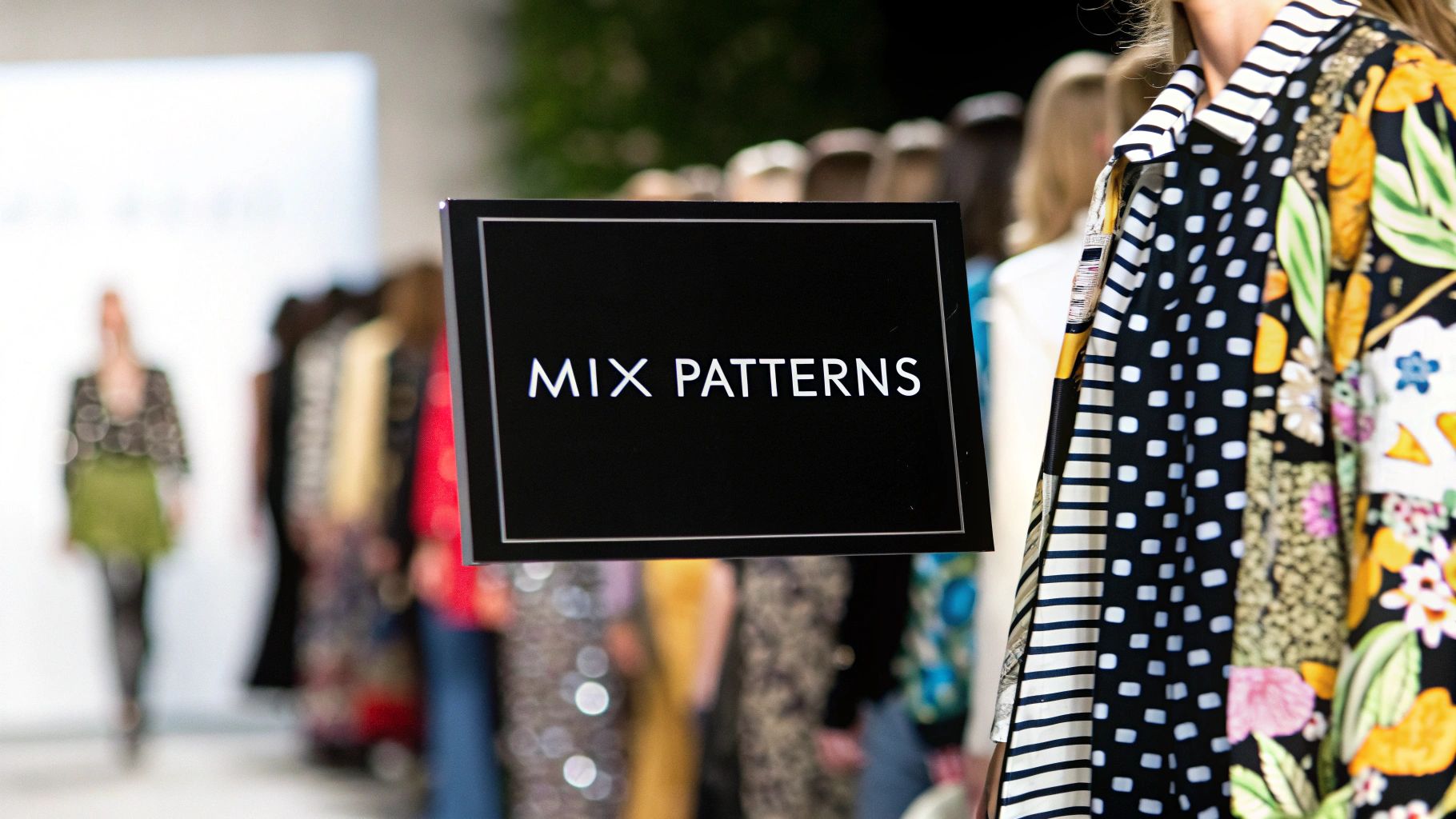
Breaking the Pattern-Mixing Myth
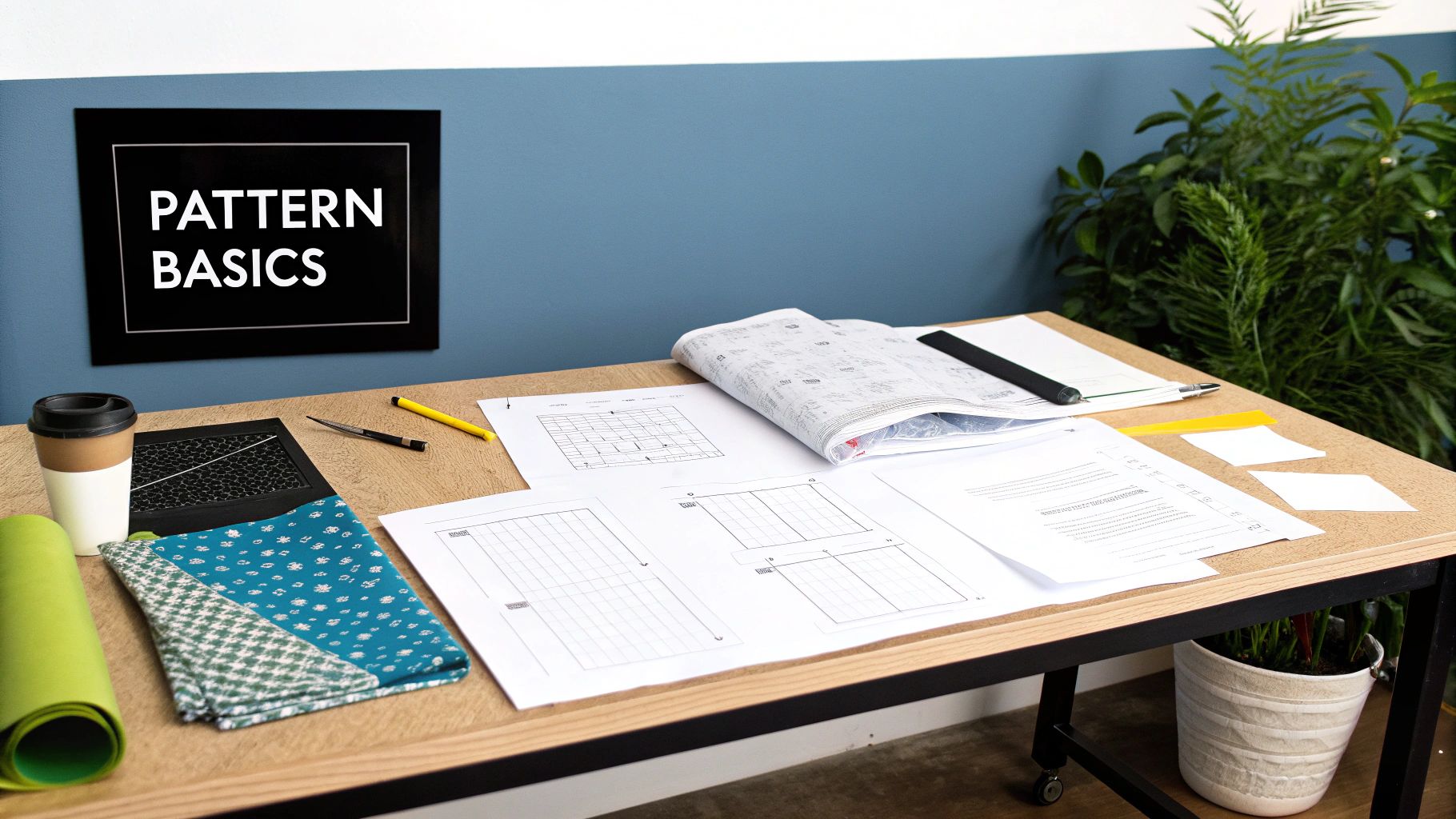
Many people hesitate to mix patterns, worried they'll create a clashing outfit. This fear often comes from the idea that pattern mixing is random. However, experienced stylists approach pattern combinations with a designer's eye. Just like an artist carefully chooses colors, a stylist uses patterns to build a visually balanced and appealing look. This involves understanding the principles of design and how they apply to pattern combinations.
Consider the impact of scale and color. Pairing a large-scale print with a smaller, more detailed one creates a dynamic and balanced effect. Using shared colors across different patterns creates a sense of harmony, even if the patterns themselves are quite distinct. This thoughtful approach, based on design principles, is far from random.
Mixing patterns has become increasingly popular in recent fashion trends. During the Spring/Summer 2023 season, 70% of major fashion shows included at least one outfit with mixed patterns. Designers like Gucci, Versace, and Dries Van Noten have embraced this trend, elevating pattern mixing from a fashion faux pas to a designer-approved technique. You can find more statistics on this trend here: How to Mix Patterns like a Pro. Successfully mixing patterns isn't just about following trends; it's about understanding the design elements that make patterns work well together.
Understanding Pattern Personalities
Each pattern has its own distinct character, from the boldness of geometric prints to the delicate flow of florals. Recognizing these "personalities" is key to successful mixing. Think of it like building a team: you want diverse individuals whose skills complement each other. Similarly, combining patterns with contrasting characteristics, like a structured stripe and an organic floral, creates a visually interesting and stylish outfit. This curated approach ensures your look is intentional and stylish, not just a random assortment of patterns.
Building Your Pattern Vocabulary
Building a versatile pattern wardrobe takes time. How to Master Pattern Mixing offers further insight into this process. Begin with a few core patterns in a cohesive color palette and gradually experiment with new additions. Think of your wardrobe as a collection of building blocks, with each pattern offering new possibilities for combinations. Understanding color, scale, and pattern personality empowers you to create looks that express your individual style with confidence. This approach allows your mixed patterns to enhance each other, showcasing your creativity and fashion sense.
The Color Connection: Your Pattern-Mixing Foundation
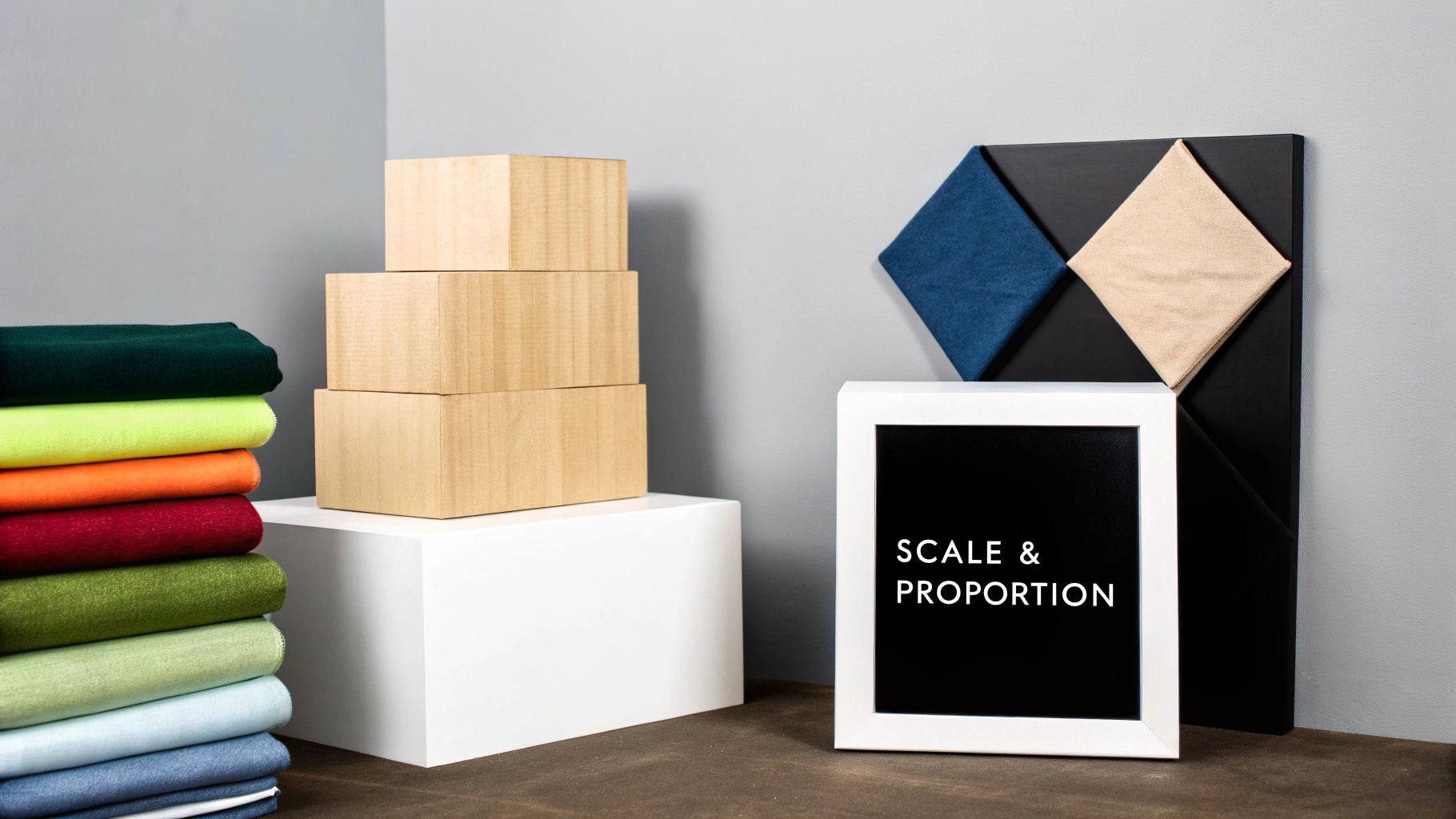
Color plays a vital role in successful pattern mixing. It connects different patterns, creating a cohesive and visually appealing final product. Understanding color relationships is as important as understanding how patterns work together. Two distinct patterns, like a floral and geometric print, can harmonize beautifully if they share a common color.
Bridging Colors: The Key to Harmony
Bridging colors are shared hues present in both patterns. These colors link the patterns, unifying the overall look and preventing a chaotic feel. Imagine a floral pattern with shades of blue and green paired with a geometric pattern incorporating the same blue. The shared blue acts as a bridge, connecting the two patterns despite differences in style or scale.
Complementary Colors: Adding a Touch of Tension
Complementary colors sit opposite each other on the color wheel. Think blue and orange, or red and green. Used strategically, these color pairings create a vibrant and energetic look when mixing patterns. This technique introduces a touch of tension, preventing the outfit from appearing too matchy. However, use complementary colors in moderation, as excessive contrast can be overwhelming.
Neutrals: Anchoring Your Pattern Play
Neutrals such as black, white, gray, beige, and navy are excellent anchoring elements for pattern mixing. These versatile colors provide a visual break, allowing the eye to transition smoothly between patterns. Neutrals ground bolder pattern combinations, creating a balanced and polished look. You can also find helpful advice on how to master color names.
Avoiding Color Misalignment
Many pattern-mixing mishaps stem not from incompatible patterns, but from color misalignment. When colors clash or lack a clear relationship, the overall look can appear disorganized. Carefully considering color is paramount to successful pattern mixing. Building your wardrobe around a strategic color palette can streamline the process and make creating harmonious outfits easier. This allows you to choose patterns that share a common color theme, simplifying the mixing and matching process.
Building a Versatile Pattern Wardrobe
Fashion designers often recommend building a versatile pattern wardrobe based on a core color palette. Choosing patterns with similar colors creates a foundation for effortless mixing and matching. For instance, a wardrobe built around navy, white, and red could include floral prints, stripes, and polka dots—all incorporating these key colors. This strategy maximizes your outfit options, allowing you to mix and match patterns confidently and stylishly.
To help illustrate effective color coordination strategies, take a look at the table below:
To further illustrate these concepts, the following table provides examples of how different color strategies can be applied when mixing patterns.
Color Coordination for Pattern Mixing
This table provides guidance on how to use color theory when mixing different patterns.
| Color Strategy | Description | Best Pattern Combinations | Example Application |
|---|---|---|---|
| Bridging Colors | Using a shared color in both patterns to create a connection. | Floral prints with a geometric print sharing a similar blue hue. | A blue and green floral blouse paired with a blue and white striped skirt. |
| Complementary Colors | Utilizing colors opposite each other on the color wheel for a vibrant look. | Orange and blue patterns. | A blue paisley scarf with an orange geometric print dress. |
| Neutrals as Anchors | Incorporating neutral colors to ground bolder pattern combinations. | Black and white stripes with a colorful floral print. | A black and white striped top with a vibrant floral skirt and a black blazer. |
By understanding these basic color principles, you can elevate your pattern-mixing skills and create truly unique and stylish outfits.
Scale Mastery: Creating Visual Hierarchy That Works
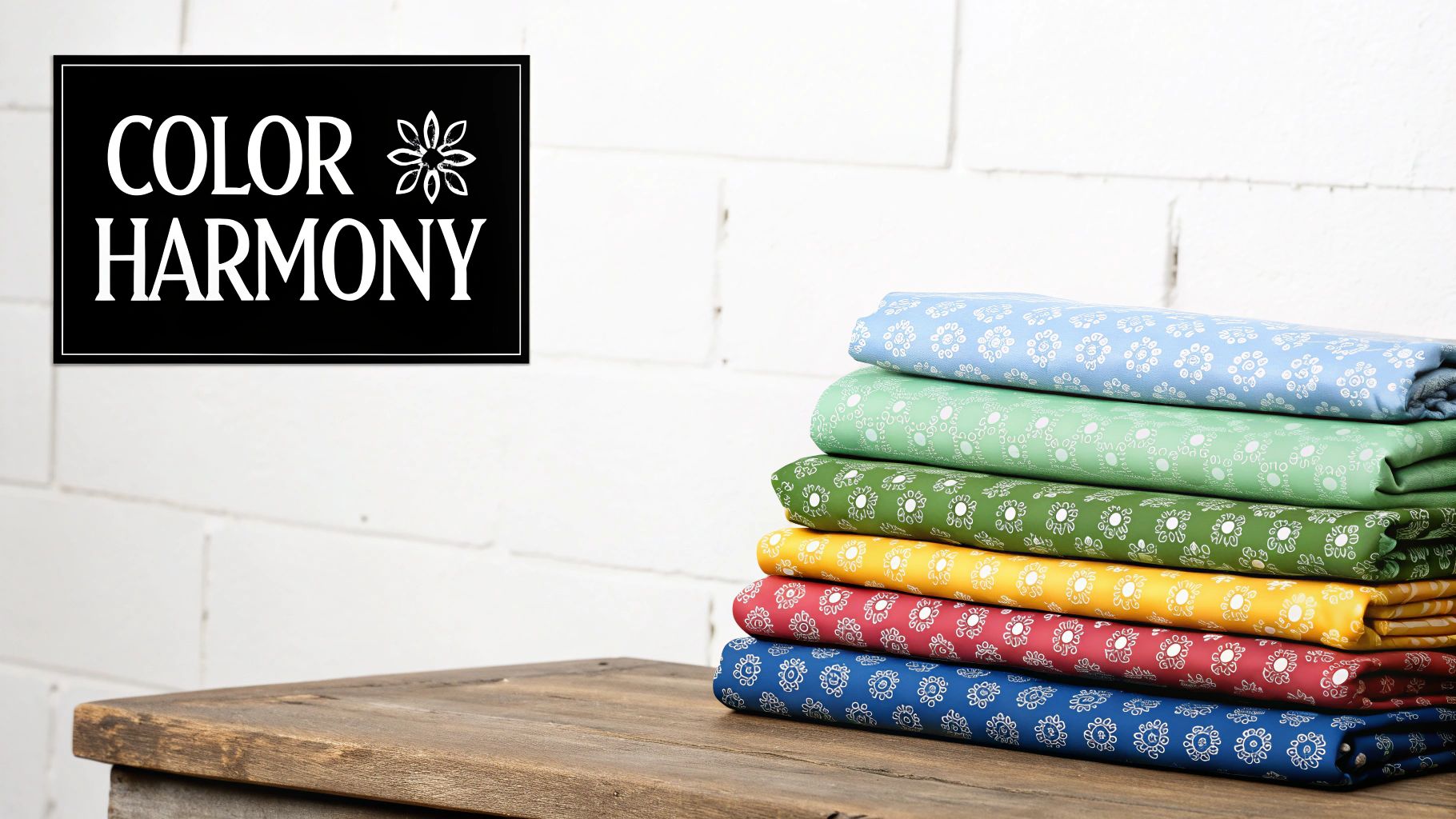
The art of mixing patterns effectively relies on understanding scale. Scale refers to the relative size of the patterns. Mastering scale is essential for a visually appealing and harmonious look, preventing a cluttered feel. It's the key difference between a polished outfit and one that seems mismatched.
This section explores how using varying pattern scales can elevate your pattern mixing.
Understanding Micro, Medium, and Macro Patterns
Think of patterns in three size categories: micro (small and intricate), medium (mid-sized), and macro (large and bold). A tiny polka dot is a micro pattern. A standard plaid is a medium pattern. A large-scale floral is a macro pattern. Visualizing these categories simplifies combining them effectively. This creates visual hierarchy, guiding the eye and balancing the overall look.
Balancing Act: Pairing Different Scales
Successful pattern combinations often involve pairing different scales. A bold, oversized floral print complements a fine pinstripe. The contrast in scale creates visual interest. It also prevents the patterns from clashing. However, combining two similarly scaled, busy patterns can be jarring. This happens because both patterns compete for attention, creating a visually overwhelming effect.
Strategic Scale Placement
You can use scale strategically to highlight or downplay certain features. A macro pattern attracts attention, while a micro pattern is more subtle. To emphasize your top half, choose a garment with a larger-scale pattern for your blouse. Then, choose a smaller-scale pattern or a solid color for your bottom. This directs the eye where you intend.
Creating Depth with Scale
Varying scale isn't just about aesthetics. It also creates depth and dimension. Layering a micro-print over a macro-print, or vice versa, adds complexity and visual richness. It’s similar to layering textures in interior design for a more interesting space. Layering patterns of different scales adds another dimension to your overall look. Brands like Versace often use intricate patterns, showcasing how designers use cultural heritage for unique designs. Historically, Versace’s fall/winter 1992 collection combined Baroque opulence with modern elements, reflecting Gianni Versace's interest in Baroque artwork. Explore this topic further. This thoughtful approach to scale adds sophistication to your pattern mixing.
Troubleshooting Scale Issues
If your mixed patterns feel overwhelming, check the scale. If two similar-scale patterns clash, try swapping one for a different scale or a solid color. If an outfit feels flat, introduce a smaller-scale accessory. A scarf or a patterned bag can add another layer of visual interest. These adjustments can transform a chaotic look into a harmonious and stylish one.
To further illustrate the impact of scale combinations, let's examine the following table:
Pattern Scale Combinations
This table shows effective combinations of different pattern scales and their visual impact.
| Pattern Combination | Visual Effect | Best Applications | Examples |
|---|---|---|---|
| Micro + Macro | Balanced contrast, visual interest | Dresses, skirts and tops, accessories with clothing | Small floral print dress with a large-scale patterned scarf |
| Medium + Micro | Subtle texture, depth | Layered tops, blouses with detailed accents | Pinstripe shirt with a small polka dot tie |
| Macro + Solid | Statement piece, focal point | Dresses, outerwear, statement tops | Large geometric print skirt with a plain white t-shirt |
| Medium + Medium (with varied patterns) | Coordinated, rhythmic | Suits, coordinated separates | Plaid blazer with a striped shirt |
| Micro + Solid | Understated texture, subtle detail | Everyday wear, minimalist outfits | Textured knit sweater with simple jeans |
This table demonstrates how combining different pattern scales can create a variety of visual effects, from subtle texture to bold statements. By understanding these combinations, you can choose the best approach for your desired look. By carefully considering how to mix patterns using scale, you’ll be well on your way to mastering the art of pattern mixing.
Strategic Pattern Pairings: Combinations That Convert
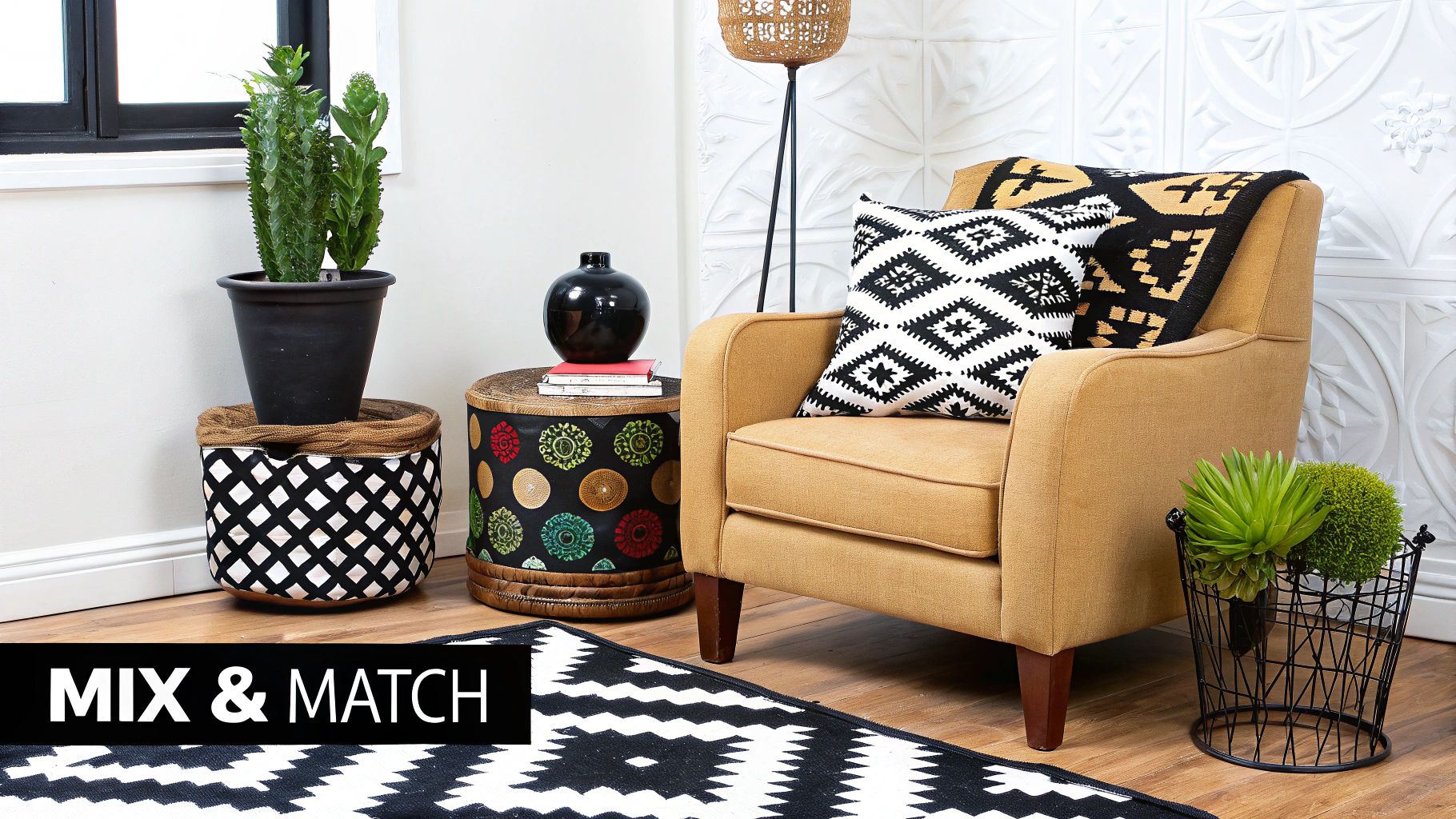
Building on the foundations of color and scale, let's explore the art of combining pattern families. This section will guide you through mixing patterns effectively by understanding their inherent characteristics. We'll move beyond basic pairings, like stripes and florals, to unlock truly unique and stylish looks.
Decoding Pattern Families
Patterns fall into distinct families: geometrics, organics, abstracts, and traditionals. Geometric patterns, such as stripes and checks, provide structure and order. Organic patterns, including florals and paisleys, introduce natural fluidity. Abstract patterns offer a modern, artistic touch. Finally, traditional patterns, like damasks and toile, evoke a classic, timeless feel. Understanding these families is the first step to strategic pattern mixing.
Understanding Pattern Personalities
Each pattern family has a unique "personality." Geometrics are structured and bold, while organics are soft and flowing. Abstracts are dynamic and expressive, and traditionals exude elegance and refinement. By recognizing these personalities, you can create intentional tension or harmony between patterns, reflecting your individual style.
Creating Intentional Combinations
Some pattern families naturally complement each other. The structured lines of geometrics often pair well with the organic curves of florals. This contrast creates visual interest and balance. The boldness of abstracts can be softened by the refined elegance of traditionals, resulting in a harmonious blend.
Unconventional Pairings for Stunning Impact
Don't shy away from unconventional combinations. Mixing geometric and abstract prints can create a surprisingly modern and chic aesthetic. Combining two organic patterns, such as a floral and a paisley, can also be effective, especially when they share a similar color palette. These unexpected pairings can elevate your style and make a statement.
Pattern Density and Texture: Adding New Dimensions
Pattern density and texture are key considerations when mixing patterns. Density describes how closely packed the motifs are within a pattern. Texture refers to the fabric's surface quality. Pairing a dense pattern with a more open, airy pattern creates balance and dynamism. Incorporating different textures, such as smooth silk with textured tweed, adds another layer of visual appeal.
Building a Versatile Pattern Wardrobe
A versatile pattern wardrobe maximizes your outfit options. Start with core patterns from different families in a cohesive color palette. Gradually introduce new patterns, experimenting with various combinations. This approach lets you create a wide range of looks, from casual to formal, with a curated selection. For more tips, explore FindTopTrends.
By understanding the interplay between pattern families, you can confidently mix and match to create stylish and impactful outfits. This knowledge empowers you to move beyond the basics and explore the endless possibilities of pattern mixing, expressing your unique style with confidence.
From Casual To Couture: Pattern Mixing Across Occasions
Pattern mixing isn't a one-size-fits-all approach. It adapts to different settings and dress codes. This section provides formulas for successful pattern combinations for various occasions, from casual weekend wear to professional attire and elegant formal events. Learning how to adjust pattern scale, contrast, and color relationships allows you to match the energy of any setting.
Casual Weekend Vibes
For relaxed weekend outings, pattern mixing can be fun and expressive. Imagine pairing a breezy floral-print sundress with a striped cardigan. This combines organic and geometric patterns while maintaining a casual feel. Accessorize with a solid-color bag and sandals to anchor the look. This allows you to experiment without feeling overdressed.
- Tip: Start with a base of neutral colors like denim or white, then add patterns through tops and accessories.
Professional Polish
In professional environments, pattern mixing requires more subtlety. A pinstriped blazer paired with a blouse featuring a small-scale geometric print creates a polished yet interesting look. This uses patterns within the same family (geometric) but varies the scale, maintaining a professional appearance while adding visual interest.
- Tip: Stick to two patterns and keep the color palette relatively subdued.
Formal Flair
Formal occasions allow for bolder pattern combinations. A patterned gown with a contrasting patterned clutch can create a stunning ensemble. If your gown features a large-scale floral print, choose a clutch with a smaller geometric or abstract pattern. This adds depth and visual interest.
- Tip: Let one pattern be the dominant focus and use the other as an accent. This creates a balanced and sophisticated look.
Accessories: Your Pattern-Mixing Gateway
Accessories offer a low-commitment entry point into pattern mixing. A printed scarf, a patterned handbag, or even patterned shoes can instantly elevate a simple outfit. For example, try adding a leopard print scarf to a solid-color dress. This adds a pop of pattern without being overwhelming.
- Tip: Use accessories to introduce a pattern that complements your outfit’s color palette, even if the pattern doesn't directly match. You might be interested in: How to master different styles.
Layering Patterns: Building Depth And Dimension
Layering patterns adds complexity and visual richness to your outfits. Start with a base layer in a solid color or a simple pattern. Then add layers with increasingly bolder or more intricate patterns. For example, a solid-color top layered under a plaid shirt and topped with a patterned jacket creates a dynamic and stylish look.
- Tip: Pay attention to the texture of your fabrics when layering patterns. Mixing different textures, like silk and wool, adds another layer of interest.
Signature Pattern Combinations
Developing a signature pattern combination can become part of your personal style. This might be a specific pairing of pattern types, like stripes and florals, or a preferred color combination. Once you find a combination you love, you can adapt it to different occasions and seasons.
- Tip: Experiment with different pattern and color combinations until you find a pairing that feels authentic to your style.
By understanding these strategies, you can confidently mix patterns to create stunning outfits for any occasion. This empowers you to express your creativity and individual style through the art of pattern mixing.
Living With Patterns: Home Décor Mixing Masterclass
Pattern mixing isn't just for fashion; it's a powerful tool for creating visually rich and layered living spaces. Just as a thoughtfully curated outfit expresses personality, the patterns in your home can do the same. This section explores how to successfully translate pattern mixing principles into interior design, transforming your home into a stylish and expressive reflection of you.
From Runway to Room: Adapting Pattern Principles
Many fashion principles apply equally to home décor. Color coordination, scale variation, and understanding pattern personalities remain crucial. A living room featuring large-scale floral wallpaper can be balanced with smaller geometric patterns on throw pillows. Just like in fashion, the goal is to create a harmonious and visually engaging experience.
Pattern Layering: Textiles, Walls, and More
Think of your home as a canvas for pattern layering. Textiles such as curtains, rugs, and throw pillows offer simple ways to introduce patterns. Wall treatments, from wallpaper to patterned paint techniques, can make a bold statement. Even floor coverings and decorative elements like artwork and ceramics contribute to the overall pattern mix. This layered approach adds depth and visual interest. Consider introducing a patterned rug to a room with solid-color furniture to create a focal point.
Commitment Levels: Starting Small, Thinking Big
Introducing patterns doesn't require a complete renovation. Start with small, low-commitment pieces like throw pillows or a patterned lampshade. As your confidence grows, incorporate larger-scale patterns through rugs, curtains, or even wallpaper. This allows you to experiment and discover what best suits your space without feeling overwhelmed.
Seasonal Shifts: Adapting Your Pattern Palette
Just as wardrobes change with the seasons, so too can your home's pattern palette. Lighter, brighter patterns create a sense of airiness in the summer. During winter, richer, warmer patterns bring coziness. This seasonal approach keeps your décor fresh and engaging. Swapping throw pillows or adding a patterned throw blanket provides a simple seasonal update.
Focal Points: Strategic Pattern Placement
Strategic placement creates eye-catching focal points. A boldly patterned accent wall draws the eye and defines a space. A patterned rug can anchor a seating area. This targeted approach adds impact and personality. For example, a vibrant geometric rug in the dining room injects energy and visual interest.
Troubleshooting Common Pattern Challenges
If a room feels too busy, introduce solid colors for visual breaks. If a space feels flat, add patterns through accessories or textured elements. Balancing different patterns, just as in fashion, is key to a harmonious look. When mixing multiple patterns, ensure they share at least one common color to tie the room together, creating unity and preventing clashes.
Ready to transform your home into a stylish and personalized haven? FindTopTrends offers a curated selection of home décor, from patterned rugs and throw pillows to unique decorative accents, helping you achieve your perfect pattern mix. Visit FindTopTrends today for endless inspiration and create a home that reflects your unique style.





